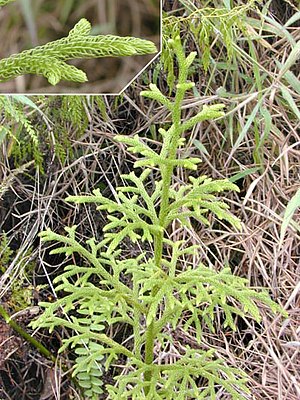Palhinhaea cernua
| Palhinhaea cernua | |
|---|---|

| |
| Scientific classification | |
| Kingdom: | Plantae |
| Clade: | Tracheophytes |
| Clade: | Lycophytes |
| Class: | Lycopodiopsida |
| Order: | Lycopodiales |
| Family: | Lycopodiaceae |
| Genus: | Palhinhaea |
| Species: | P. cernua
|
| Binomial name | |
| Palhinhaea cernua | |
| Synonyms[2] | |
| |
Palhinhaea cernua, synonym Lycopodiella cernua, is a plant in the family Lycopodiaceae,[2] commonly known as the staghorn clubmoss.[3] The Hawaiian name for the plant is wāwaeʻiole, or "rat's foot". It has a substantial number of scientific synonyms in several genera. The genus Palhinhaea is accepted in the Pteridophyte Phylogeny Group classification of 2016 (PPG I),[4] but not in other classifications which submerge the genus in Lycopodiella.[5]
Distribution
Palhinhaea cernua is a widespread pan-tropical species, found mostly at higher elevations in subtropical mountain climates of tropical Africa, Asia, the Pacific Islands and the Neotropics. In Europe, it is found in the Azores (where it is possibly native) and formerly on Madeira. It has been introduced in continental Portugal (Valongo), Sicily and Malta.[1]
It favors bog environments.
Palhinhaea cernua is sometimes cultivated.
References
- ^ a b Christenhusz, M., Bento Elias, R., Dyer, R., Ivanenko, Y., Rouhan, G., Rumsey, F. & Väre, H. (2017). "Palhinhaea cernua". IUCN Red List of Threatened Species. 2017: e.T83571087A83571205. Retrieved 23 August 2021.
{{cite journal}}: CS1 maint: multiple names: authors list (link) - ^ a b c Hassler, Michael & Schmitt, Bernd (November 2019). "Palhinhaea cernua". Checklist of Ferns and Lycophytes of the World. 8.11. Retrieved 2019-12-06.
- ^ USDA, NRCS (n.d.). "Lycopodiella cernua". The PLANTS Database (plants.usda.gov). Greensboro, North Carolina: National Plant Data Team. Retrieved 26 July 2016.
- ^ PPG I (2016). "A community-derived classification for extant lycophytes and ferns". Journal of Systematics and Evolution. 54 (6): 563–603. doi:10.1111/jse.12229. S2CID 39980610.
- ^ Christenhusz, Maarten J.M. & Chase, Mark W. (2014). "Trends and concepts in fern classification". Annals of Botany. 113 (9): 571–594. doi:10.1093/aob/mct299. PMC 3936591. PMID 24532607.
Further reading
- Cook Islands Biodiversity Database: http://cookislands.bishopmuseum.org/species.asp?id=6348
- In efloras: http://www.efloras.org/florataxon.aspx?flora_id=12&taxon_id=242330770
- Dressler, S.; Schmidt, M. & Zizka, G. (2014). "Lycopodium cernuum". African plants – a Photo Guide. Frankfurt/Main: Forschungsinstitut Senckenberg.Error: "Q10929002" is not a valid Wikidata entity ID.
Error: "Q6707390" is not a valid Wikidata entity ID.
Error: "Q21976240" is not a valid Wikidata entity ID.
- CS1 maint: multiple names: authors list
- Articles with short description
- NatureServe secure species
- IUCN Red List least concern species
- Articles with 'species' microformats
- Taxonbars desynced from Wikidata
- Taxonbar pages requiring a Wikidata item
- Taxonbars with invalid from parameters
- Taxonbars with multiple manual Wikidata items
- Taxonbars without secondary Wikidata taxon IDs
- Lycopodiaceae
- All stub articles
- Lycophyte stubs

